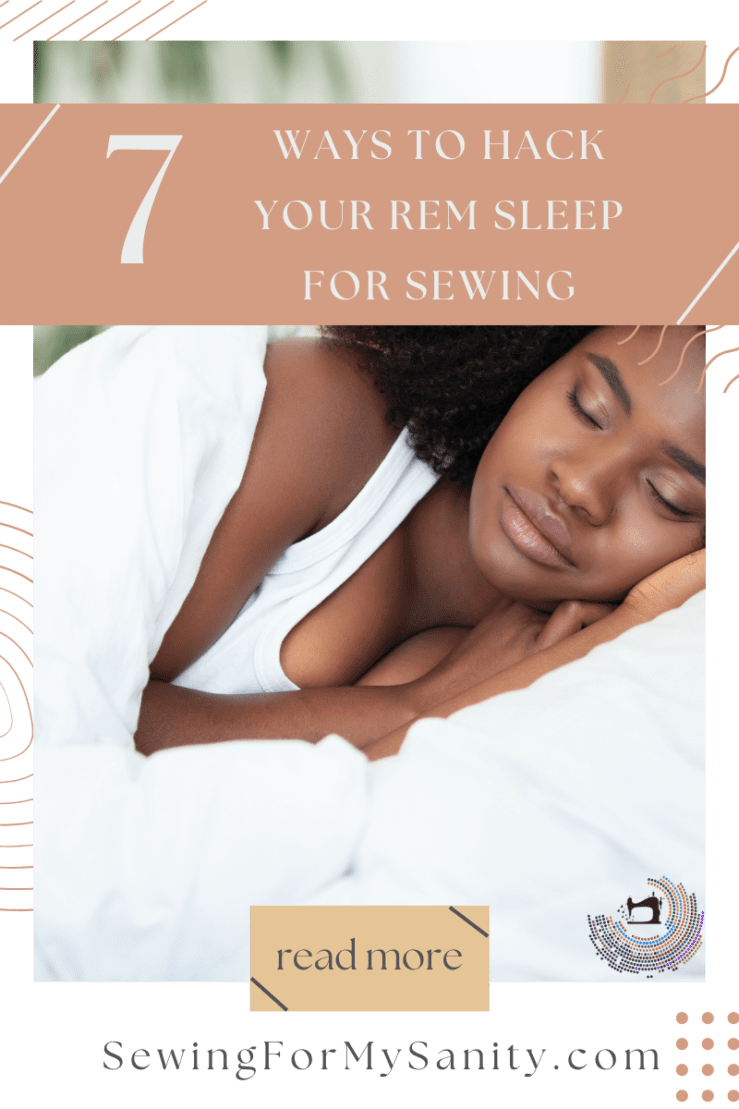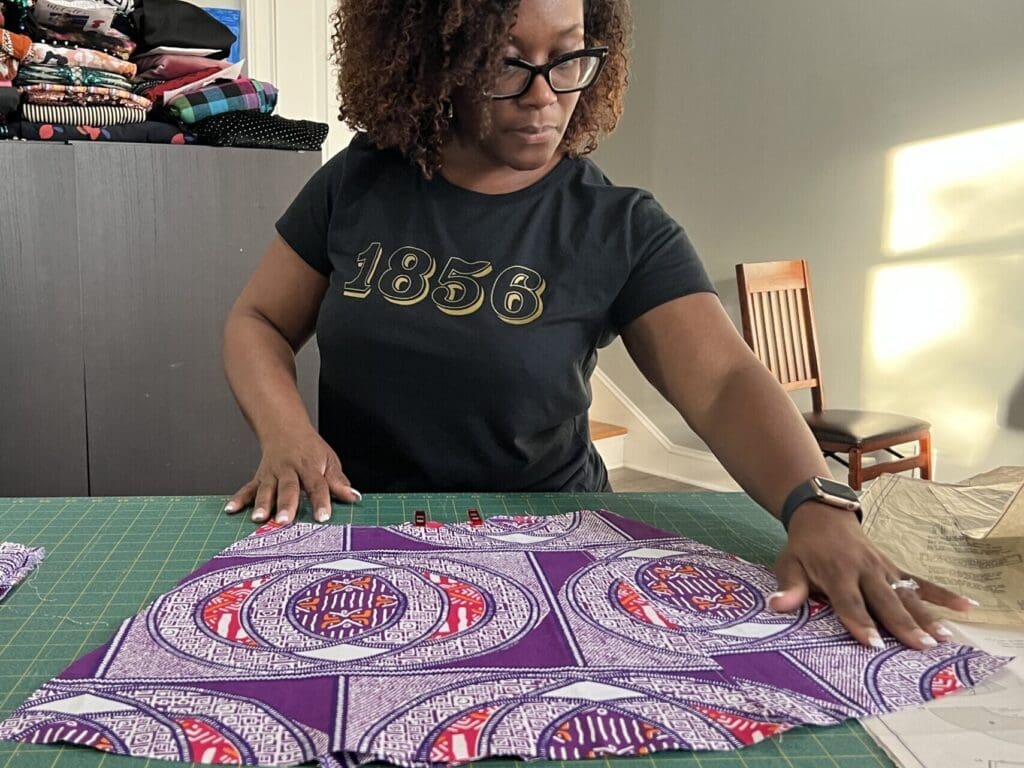Sleep for Creativity: 7 Ways to Hack Your REM

I’m a lifelong learner, so it should be no surprise that I’m writing about REM sleep and creativity. Having a constant sewjo is essential to making and recreating gorgeous garments. In medical school and undergrad at Stanford University, I witnessed way too many all-nighters. I struggled with staying up all night and learning but was forced into sleep deprivation during residency.
The Link Between Creativity and Sleep
As humans, we all have a certain level of creative potential. Whether it’s writing, painting, music, or even problem-solving, our creativity allows us to think outside the box and develop new ideas. As a sewist, you have unlimited creative juices.
A good night’s rest is so important for unleashing our creative potential. The quality and quantity of sleep we get can significantly impact our sewing creativity. This blog post explores the link between creativity and sleep.
Why Sleep is Important for Creativity
Our brains are incredibly active and express creativity while we’re asleep, with different parts of the brain processing and consolidating information. This is especially true during REM (rapid eye movement) sleep when we do most of our dreaming. REM stands for Rapid Eye Movement, a sleep phase characterized by rapid eye movements and increased brain activity. During REM sleep, our eyes move rapidly in various directions, and our brain activity is similar to when awake. REM sleep is essential for many vital functions, including memory consolidation, learning, and emotional regulation. It is also the stage of sleep where most dreaming occurs.
If we connect that to sewing, when we sew, we learn. One skill builds on the next. You are problem-solving each piece.

Matching plaids and stripes, inserting zippers, and pattern reading all require executive function and brain processing that are solidified as you sleep.
REM, not the band
REM (Rapid Eye Movement) sleep is a stage of sleep with rapid eye movements, vivid dreaming, and increased brain activity. While no conclusive scientific evidence directly links REM sleep to creativity, it is widely believed to play a significant role in the creative process.
The cycles of REM sleep alternate with non-REM sleep stages throughout the night. Each cycle typically lasts around 90 minutes, and as the night progresses, the amount of REM sleep increases while the duration of non-REM sleep decreases.
Studies have shown that people who get more REM sleep are more creative than those who don’t. This is because REM sleep helps to consolidate memories and experiences, which can be used as fuel for creative thinking.
Sleep and Creativity
Here’s how REM sleep can potentially affect creativity:
- Dreaming: REM sleep is when most dreaming occurs, and dreams have inspired many creative individuals throughout history. Dreams can be a source of new ideas, novel connections, and imaginative scenarios, which can fuel the creative process.
- Memory consolidation: Memory consolidation occurs in REM sleep, strengthening and integrating new information into existing memory networks. This consolidation process can enhance creative thinking by allowing the brain to form new connections between seemingly unrelated concepts or ideas.
- Associative thinking: During REM sleep, the brain’s activity patterns are characterized by increased connectivity between different brain regions. This enhanced connectivity may facilitate associative thinking, which is crucial for creative problem-solving and idea generation. REM sleep might help the brain make unexpected connections and form unique associations, leading to creative insights.
- Emotional processing: REM sleep is also involved in emotional processing and regulation. Emotional experiences can greatly influence creativity, as they provide the fuel for expressing ideas and evoking emotions in artistic and creative works. REM sleep may contribute to emotional processing, enabling individuals to explore and express their emotions more effectively in their creative endeavors.
A lack of quality REM sleep can negatively affect our physical and mental health, such as fatigue, irritability, difficulty concentrating, memory problems, and mood swings. It is, therefore, crucial to ensure that we get enough quality REM sleep each night to support our overall well-being and sewing and creative efforts.
Impact of Sleep Deprivation on Cognitive Function
Lack of sleep can significantly impact other cognitive functions besides creativity.
- Attention and Concentration
When we don’t get enough sleep, our ability to focus and concentrate on tasks can suffer, making it more difficult to complete complex or demanding tasks requiring sustained attention. Therefore, sleep and creativity go hand in hand. Sewing can be complex and require lots of concentration. We also need to concentrate for safety reasons– dealing with needles and scissors. I ensured she slept well before my daughter and I made Simplicity 1290. - Memory and Learning Abilities
Forming new memories or holding onto essential details can be challenging without adequate sleep. Sewing involves creativity and multiple steps requiring memory, like installing horsehair braid like in McCalls 7356. - Decision-making Abilities and Problem-solving Skills
When we are tired, we tend to be more impulsive and less able to think through problems logically, affecting our ability to make good decisions. Impulsivity can spark creativity without sleep and lead to sewing mistakes and mishaps. Ever struggle with trying to figure out which fabric to choose or what thread color to put in the bobbin? - Mood Regulation
Finally, sleep is essential for mood regulation, and lack of sleep can contribute to increased stress levels, irritability, and even depression in some cases. Even with my winter blues, sleep improves the sad feelings.
Rest and Recharge
Another way that sleep helps to boost creativity is by giving our brains a chance to rest and recharge. When we’re awake, our brains constantly process information, which can lead to mental fatigue. By getting a good night’s sleep, we give our brains a break from this constant processing, which can help to improve our cognitive abilities and make us more creative.
Tips for Getting Better Sleep and Creativity
1. Creative minds need a schedule.
That means trying to get to bed at the same time every night and waking up at the same time every day.
2. Avoid caffeine and other stimulants before bed.
That means no midnight coffee jams, Redbull, and shots of tea. Caffeine interrupts the body’s ability to shut down entirely, so for some, even small amounts of caffeine can disturb sleep and block your slumbering creative flow.
3. Exercise regularly for better sewing and creativity
To achieve optimal sleep health, it’s important to incorporate moderate-intensity aerobic activity into your daily routine. By committing to 30-minute workouts for five days a week, you’ll experience consistent sleep benefits. If 30 minutes seems challenging, try breaking it up into two 15-minute workouts daily. And if you’re up for a more intense challenge, aim for at least 75 minutes of vigorous-intensity activity each week. Remember to avoid exercising right before bedtime and find an activity that you enjoy to make it a sustainable part of your daily routine.
4. Practice relaxation techniques
One can employ different relaxation techniques in order to facilitate falling asleep. In fact, relaxation is great for creativity in general not just sleep. For instance, deep breathing, meditation, and progressive muscle relaxation are some of the methods that can be employed. From my personal experience, I have found that performing stretching exercises and reflecting on the things that I am grateful for, such as sewing while stretching, can be quite effective in calming my mind and aiding me in drifting off to sleep.
5. Keep it Chilly
To improve the quality of your sleep, experts recommend turning off electronics and keeping the room cool and dark. Keeping the bedroom cool at night can benefit sleep quality and overall health. Cooler temperatures can help to promote sleepiness by mimicking the body’s natural drop in temperature during the evening. Improves sleep quality: A more comfortable room temperature (around 60-68°F or 15-20°C) can help to facilitate more profound, more restorative sleep. Sleeping in a chilly environment may risk certain health conditions, such as metabolic diseases like diabetes and obesity. It also helps regulate the body’s melatonin production, a hormone that regulates the sleep-wake cycle. Cooler temperatures may improve your mood by reducing stress and promoting calmness.
6. Take a nap, a power nap
Indeed, it is a well-known fact that when you come across a difficult task, taking a brief power nap in the middle of the day can work wonders. It can help refresh your mind and body, allowing you to approach the task with renewed energy and clarity. It’s definitely something worth considering if you want to increase your productivity and efficiency.
- Mood.
- Alertness.
- Reaction time.
- Short-term memory.
- Focus and concentration.
If you happened to have stayed up late last night with your creative sewing juices and find yourself with some free time today, it may be worthwhile to consider taking a longer nap. Experts suggest that a nap lasting anywhere from an hour to 90 minutes can help make up for the lost sleep from the previous night. In fact, research has shown that longer naps can even improve your memory recall and enhance your creative thinking abilities. So, if you’re feeling a bit sluggish or forgetful, a longer nap could be just what you need to recharge your mind and body.
7. Turn off the screen, turn on sleep mode creativity
If you are looking to guarantee a restful and uninterrupted night’s sleep, it is highly recommended that you steer clear of using electronic devices such as televisions, smartphones, and laptops for at least 30 minutes prior to bedtime. The reason for this is that the light emitted from these devices can have a stimulating effect on your brain, which can ultimately lead to difficulties in falling asleep. By avoiding the use of these devices before bed, you can give your mind and body the opportunity to unwind and relax, setting the stage for a peaceful and rejuvenating night’s sleep.
Conclusion
Sleep quality is critical for optimal cognitive function and overall health and well-being. So the next time you struggle to come up with a great idea, remember the importance of a good night’s sleep!
It’s important to note that creativity is a complex and multifaceted phenomenon influenced by various factors, including personal experiences, environment, and cognitive processes. While REM sleep has been suggested to impact creativity positively, it is just one piece of the puzzle. Other stages of sleep and waking life experiences also contribute to creative thinking and innovation.
© 2023 Social Graces LLC. All rights reserved. Our website services, content, and products are for informational purposes only. Sewing For My Sanity does not provide medical advice, diagnosis, or treatment.
